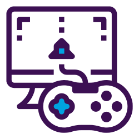Somewhere in my preparations for the learning gamification training in Kuala Lumpur, I came across the work of Caine & Caine regarding the 12 Brain/Mind Natural Learning Principles. Whilst reading them through I felt they were totally appropriate for how I see they can contribute to learning with gamification, virtual and augmented reality. The more we can use all of our body to learn new skills the better.
They created a fabulous easy to understand summary of the principles, which I am sharing here below and which was originally published on www.cainelearning.com. It is a highly recommendable read.
“Each Principle reveals a capacity that all students have for learning language and comprehending text
Principle #1: All learning engages the physiology.
One reason so much traditional comprehension teaching involves students sitting in their assigned seats is the belief that the brain is somehow separate from the body and that the body is not very involved in learning. The research on neural plasticity, as well as other research (Diamond, M.C. & Hobson, J., 1998; Capra, F.,1996; Damasio, A. R., 1994; Thelen, E. & Smith, L. ,1994 ), tells us that the body and mind are totally interconnected. Cognitive scientists often refer to this in terms of embodied cognition (See e.g. Lakoff and Johnson,1999).
Capacity #1: All students have the capacity to comprehend more effectively when involved in experiences that naturally call on the use of their senses and their bodies.
Principle #2: The brain/mind is social.
Every individual on this planet comes complete with what Gopnik, Meltzoff, & Kuhl (1999) have called the “contact urge.” Recent research on mirror neurons confirms that the social nature of human beings is grounded in biology. The social nature of learning is sometimes described in terms of situated learning (see e.g. Lave et.al.,1991). In the world beyond education, the social nature of learning is made practical by the use of communities of practice (Wenger et. al. 1999).
Capacity #2: All students have the capacity to comprehend more effectively when their needs for social interactions and relationship are engaged and honored.
Principle #3: The search for meaning is innate.
The need to make sense of things is characteristic of every human being from infancy to adulthood. It has been called the “explanatory drive” (Gopnik, Meltzoff, & Kuhl, 1999). One aspect of even young students’ search for meaning is illustrated by the way that all people respond to novelty. For example, “in reading a text on one of Christopher Columbus’s voyages, imagine yourself as a rat on the ship. What is your point of view of the voyage?” Another aspect has to do with the compelling power of purpose (Hillman, 1997). For example, a girl of about 9 years old recently described what she understood to be the causes and best treatment for breast cancer. She was extremely articulate. Her interest had been sparked by the fact that her mother had been diagnosed with the disease, prompting her to read as much as she could find on the subject.
Capacity #3: All students have the capacity to comprehend more effectively when their interests, purposes and ideas are engaged and honored.
Principle #4: The search for meaning occurs through patterning.
Patterning refers to the meaningful organization and categorization of information. People make sense of experience by their mind’s drive to find and create patterns and relationships. The brain is designed to perceive and generate patterns (Restak, 1996) and resists having meaningless patterns imposed on it by others. Cognitive scientists have developed a large number of terms in order to describe patterning, terms such as categories, frames, and schemata. Indeed, one way to look at standards is as a set of ways in which society has organized experience into patterns, ranging from language and history to math and science.
Capacity #4: All students have substantial unused capacities to perceive and create patterns and to link those new patterns to what they already understand.
Principle #5: Emotions are critical to patterning.
Emotions are central to human life. Neuroscience now confirms (Pert 1997, Damasio 1999) what writers and artists have long known, that emotions are involved in every thought, decision, and response. Powerful learning is enhanced by rich emotional experiences, guided and moderated by higher order functions. In fact, emotion and physical reactions are so much a part of understanding that psychologist Eugene Gendlin (1981) describes the link in terms of the phrase “felt meaning.”
Capacity #5: All students can comprehend more effectively when appropriate emotions are elicited before, during, and after their experiences with a text.
Principle #6: The brain/mind processes parts and wholes simultaneously.
Making sense of experience requires both a big picture and paying attention to the individual parts. The experience of the whole provides a story, a model, or a fascinating example of what can be achieved. Gestalt psychology (Sternberg, 2006) explicitly shows how the mind connects parts to make these wholes. And some of the most recent brain research is now exploring the integrative role of the prefrontal cortex (Fuster, 2003).
Capacity #6: All students can comprehend more effectively when details (specific facts and information) are embedded in wholes that they understand such as a real life event, a meaningful story, or a project that they create or witness.
Principle #7: Learning involves both focused attention and peripheral perception.
Every human being is continuously immersed in a field of stimuli, and constantly selects a part of that field to attend to. Attention is a natural phenomenon guided by interest, novelty, emotion, and meaning, and paying attention is critical. What is less understood is the fact that human beings also learn from the background – the context that is not consciously attended to. This is illustrated by research on implicit memory (Schacter,1996) as well as mirror neurons (Rizzolatti, G., & Craighero, L., 2004) which shows how children “pick up” behaviors, beliefs, and preferences or dislikes while engaging in life experience.
Capacity #7: All students can comprehend more effectively when their attention is deepened and multiple layers of the context are used to support learning.
Principle #8: Learning is both conscious and unconscious.
Learning involves layers of consciousness. Some learning requires a person to consciously attend to a problem that needs to be solved or analyzed. At other times, learning calls unconscious incubation in the same way that the creative insights of artists and scientists sometimes occur after the mind has done some conscious processing.
Beyond both of these levels is the capacity of learners to engage in metacognition and monitor themselves by means of the executive functions of their brains (Denkla, 1999) – a central feature of higher order functions – so that they know their own strengths and weaknesses and can take charge of how they process text.
Capacity #8: All students can comprehend more effectively when given time to reflect on and process those experiences about which they live and read.
Principle #9: There are at least two approaches to memory.
Researchers have identified many different memory systems. These tend to be organized into two primary categories – explicit and implicit memories. However, of more value educators is the separation of memories in a slightly different way. (One type of memory is designed to store or archive isolated facts, skills, and procedures read or taught as strategies to comprehend a text. Another type of memory is very dynamic in that it engages multiple mental systems in order to organize ongoing life experience itself. O’Keefe and Nadel, 1978). That is why educators need to understand is between rote memorization, which has a role but which is the hallmark of traditional approaches to schooling, and the dynamic memory that is engaged in everyday experience and which is engaged through infotainment.
Capacity #9: All students can comprehend more effectively when immersed in experiences that engage multiple ways to remember.
Principle #10: Learning is developmental.
All human beings develop in several somewhat predictable ways, though rarely in precisely the same way or at exactly the same rate. There are stages in brain development (Bransford et.a., 2000; Sylwester, 2007) for instance, and in the formation of identity, all of which impact comprehension and skill development. In addition, all learning builds on previous learning. We now know that this additive/cumulative process is accompanied by changes in the physiology (Huttenlocher, 2002) of the brain. This mental alteration is in turn altered by new experiences, and the cycle continues throughout life. Unfortunately, the traditional age/grade organization of students does not adequately deal with the realities of their mental and emotional development.
Capacity #10: All students can comprehend more effectively if individual differences in maturation, development, and prior learning are taken into consideration.
Principle #11: Complex learning is enhanced by challenge and inhibited by threat associated with helplessness and/or fatigue.
A great deal of research from such disciplines as neuroscience (e.g. LeDoux 1996), creativity theory (Deci & Ryan 1987), stress theory (Sapolsky, 1998; Lazarus, 1999) perceptual psychology, (Combs, 1999) shows that effective mental and emotional functioning can be sabotaged by fears associated with helplessness. One consequence of such frightened negative emotions is that higher order executive functioning are hijacked. That is why the optimal state of mind for learning is relaxed alertness, a combination of low threat and high challenge.
Capacity #11: All students can comprehend more effectively in a supportive, empowering, and intrinsically challenging environment.
Principle #12: Each brain is uniquely organized.
The paradox that faces education is that human beings are both similar and different. For example, every human being is an expression of DNA. Yet every individual has a unique genetic blueprint. Everyone has a lifetime of experience, and yet some of the experiences of every person are unique. All of this complexity is compounded by a wide variety of social, ethnic, gender, and economic differences.
Capacity #12: All students can comprehend more effectively when their unique, individual talents, abilities, and capacities are engaged.”
I have to say although I never studied these principles before, they do confirm what I have experienced in being involved in learning and development for over 15 years and with my own learning. The key take-away for me is the importance of encouraging multiple senses, emotions, providing a positive environment and working towards every individuals’ strengths. In gamification designs for learning, the more we can incorporate of these principles and make our work adapt to the individual and their senses the better.



